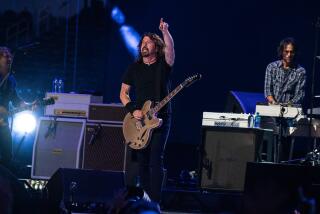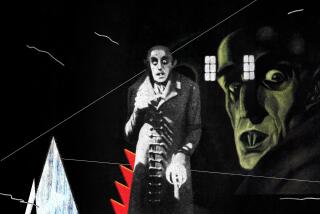Foo Fighters frontman examines Van Nuys recording history in ‘Sound City’
Amid the splintered drum sticks and empty coffee cups littering his Northridge recording studio, Dave Grohl contemplated the enormous mixing desk before him.
The Foo Fighters frontman looked at the seemingly endless rows of faders and dials on the console, admiring it like a car lover might a vintage Aston Martin.
“I consider that board to be responsible for the person I am today,” said the former drummer of Nirvana. “Had it not been for that board, who knows what ‘Nevermind’ would’ve sounded like. And who knows if anyone would ever have heard of Nirvana.”
PHOTOS: Sundance Film Festival 2013 - Dramas in competition
The custom-designed Neve console came from Sound City, the Van Nuys recording facility where acts such as Fleetwood Mac, Metallica and Tom Petty and the Heartbreakers — as well as Nirvana — made some of their best-known albums.
Dressed in a brown hoodie and blue jeans, Grohl, 44, was preparing for the premiere of his documentary about the studio and its lore, “Sound City,” which was scheduled to debut Friday at the Sundance Film Festival in Park City, Utah. He’d pulled together an all-star band of Sound City alumni to celebrate the premiere and was rehearsing last week for the show.
Three large poster boards rested on easels in the main room, each scrawled with a dozen song titles: “Landslide.” “Jessie’s Girl.” “Born on the Bayou.” Rick Springfield was due over in a few hours; Stevie Nicks and John Fogerty were to drop by in coming days.
The Sound City Players, whose lineup also includes Trent Reznor, Nirvana’s Krist Novoselic and members of Cheap Trick and Rage Against the Machine, have an album out March 12. In addition to a performance at Sundance, they will play the Hollywood Palladium on Jan. 31, following a screening of the movie at ArcLight Cinemas’ Cinerama Dome.
“You can imagine, logistically, this was almost impossible to put together,” Grohl said with a shake of his shoulder-length hair. “But now that we did, it’s blowing my mind.”
The studio that united these artists seems to pale in comparison to the talent it incubated. Tucked behind a grungy facade across the street from a food-truck depot, Sound City today appears no more impressive from the outside than it did during the decades following its opening in 1969.
“The place basically looked like a white-trash double-wide,” said Springfield, who recorded his 1981 album “Working Class Dog” at the 7,200-square-foot studio. “You went into the bathrooms afraid you might catch something.”
Yet a mystique developed early on around Sound City, and the allure went beyond sonics. Neil Young recorded parts of the classic “After the Gold Rush” there, Petty did “Damn the Torpedos” there, and Charles Manson reportedly cut tracks in the studio shortly before he became famous for an entirely different reason.
“It was like a club,” said Nicks. The Fleetwood Mac frontwoman acknowledged that getting to Sound City, deep in the San Fernando Valley, was hardly convenient for rock stars living closer to top-flight studios in Hollywood or Santa Monica. “But once you were in, you were in, and so you made the trip out there as often as you could.”
Business stayed strong throughout the ‘80s with sessions by hair metal bands such as Ratt, but after Nirvana made “Nevermind” there in 1991 — and the album went on to sell 10 million copies — Sound City found a second life as an alternative-rock hot spot.
Throughout the rest of the ‘90s band after band came seeking what “Nevermind” producer Butch Vig described as the studio’s “one-of-a-kind vibe.” “The acoustics in the room — there was just something about them that made everything sound amazing,” he said.
By the middle of the next decade, though, the music industry’s slowdown and advances in home-recording equipment had cut seriously into Sound City’s business. Bookings dried up and in 2011 Kevin Augunas, an L.A.-based producer who’s worked with the Lumineers and Cold War Kids, took over the studio and remodeled it; he uses it now primarily to record bands signed to his label, Fairfax Recordings.
Grohl began work on “Sound City” after he bought the Neve board, which he moved to his place in Northridge. His original idea was to make a short film in conjunction with the 20th anniversary of “Nevermind.” But once he started interviewing other artists who’d recorded at Sound City — each rhapsodizing at length over the experience — “I realized this was a real movie,” he said.
“Dave didn’t sound like some guy pitching an idea, like in ‘The Player,’” said Fogerty, referring to Robert Altman’s 1992 Hollywood satire. “He sounded like a little boy. I could tell his enthusiasm was pure.”
A message materialized along with his cast.
“I wanted to talk about the human element in music,” said Grohl, a first-time filmmaker who recruited a couple of veteran documentarians in writer Mark Monroe (“The Cove”) and editor Paul Crowder (“Dogtown and Z-Boys”). “I wanted to talk about technology and how it’s impacted the way we make music and the studio industry. And I wanted to demonstrate those things at the end of the film.”
That demonstration — in which we see the Sound City Players come together to create new songs, sometimes in just a matter of hours — is the part of Grohl’s movie likely to expand its appeal beyond gearheads and music nerds.
One especially memorable sequence depicts the surviving members of Nirvana (whose singer Kurt Cobain died in 1994) with Paul McCartney as they write and record “Cut Me Some Slack,” the hard-driving blues-punk number they performed during the 12-12-12 Hurricane Sandy benefit at New York’s Madison Square Garden.
And it’s a quiet thrill to watch Nicks, singing lyrics she said she wrote about the death of her godson, open herself up to new musical partners. “That was intense,” said Grohl, who later admitted he’d failed to come through on at least one hoped-for collaboration: Barry Manilow and Weezer. “I got so close,” he sighed.
“The film really works on two levels,” said James Moll, whose documentary “Back and Forth” examined the making of Foo Fighters’ 2011 album “Wasting Light.” “It’s great for people who understand the technology but also for a general audience interested in people.”
The latter was more important to Grohl. His intention with “Sound City,” he said, is to inspire “an appreciation for the sound of four human beings writing a song in an afternoon and walking away fulfilled.” It’s a lesson he remembers learning from “The Decline of Western Civilization,” Penelope Spheeris’ cult-classic look at the early-’80s L.A. punk scene.
“The energy of that music and the energy of that time was captured so perfectly in that movie,” he said. “That’s what you’re trying to do. You’re trying to capture magic.”
MORE SUNDANCE COVERAGE
VIDEO: A video guide to Sundance 2013
More to Read
From the Oscars to the Emmys.
Get the Envelope newsletter for exclusive awards season coverage, behind-the-scenes stories from the Envelope podcast and columnist Glenn Whipp’s must-read analysis.
You may occasionally receive promotional content from the Los Angeles Times.








